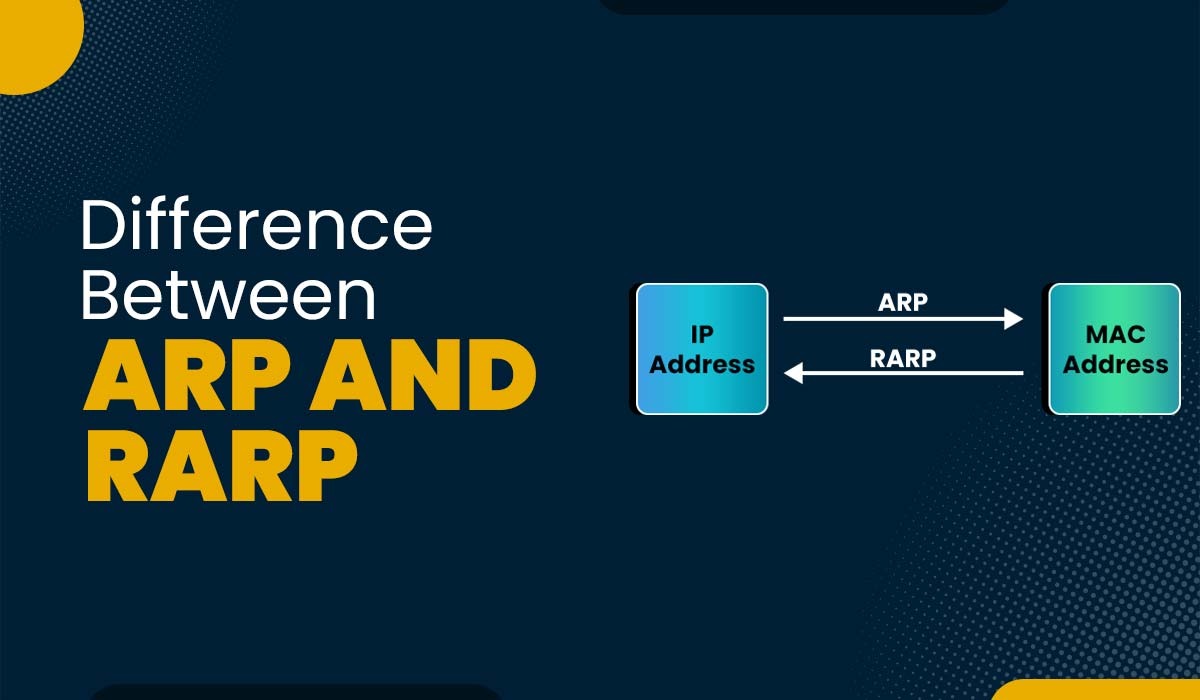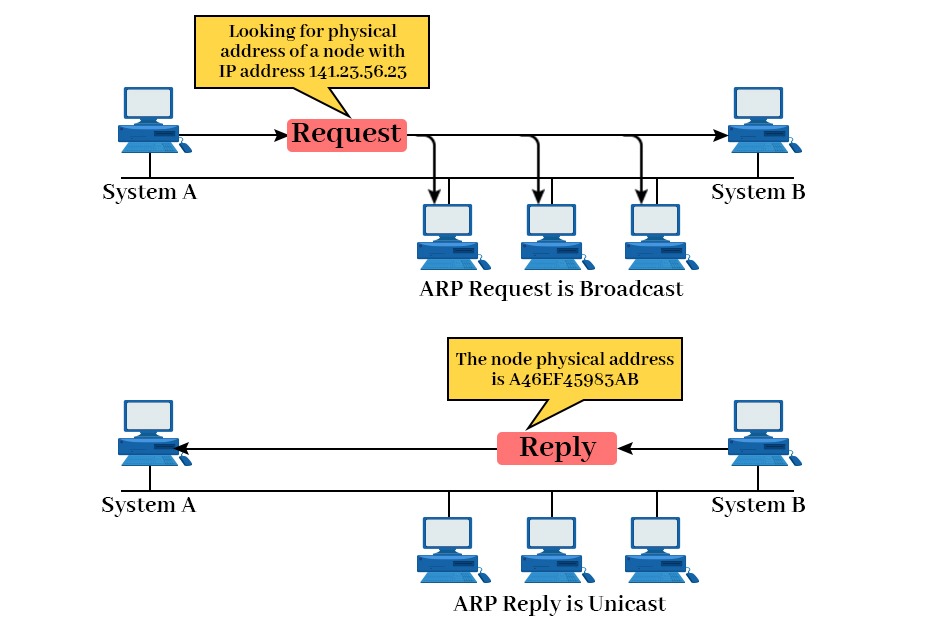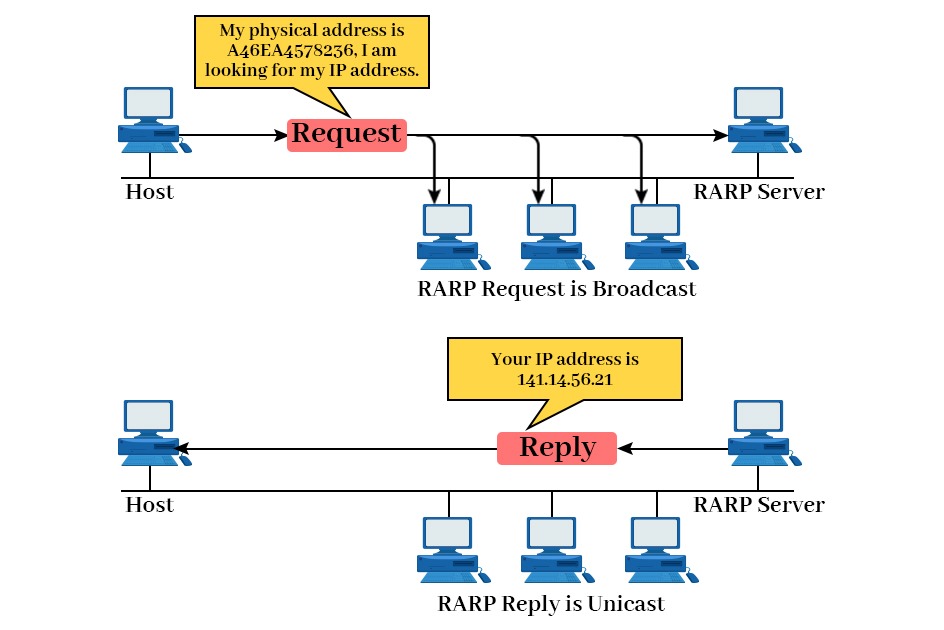Difference between ARP and RARP

In computer networking, it is crucial to map a logical address (such as an IP address) to a physical address (such as a MAC address). The reason behind this is that network layers use different types of addresses to identify and communicate with different devices available within a network. But the question that comes to every network enthusiast’s mind is how one can find the MAC address of a device on a network. This is where ARP and RARP come into action. Both these protocols are utilized in order to perform the mapping. However, the main difference between ARP and RARP is their direction of mapping. In the case of ARP, it maps an IP address to a MAC address. On the other hand, when we talk about RARP, it is used to map a MAC address to an IP address. In this blog, we will compare ARP vs RARP to understand the difference between the two protocols, their basic definition, and how mapping is done. Let’s first understand the basic difference between the two protocols. Below, we have compared ARP vs RARP in a tabular form based on different factors. We have explained the basic difference between ARP and RARP. Suppose someone is new to the concept of ARP and RARP. Below, we have explained both these protocols along with their functioning. Let’s begin by first understanding what ARP really is. ARP, short for Address Resolution Protocol, is a protocol that enables a device to discover the MAC address of another device on the network by knowing its IP address. For instance, when a computer needs to send a packet to another computer within the local area network (LAN), it must determine the MAC address of the destination computer to encapsulate the packet into a frame. To accomplish this, ARP broadcasts a request message containing its IP and MAC addresses along with the destination IP address. The device that possesses the IP address then responds with an ARP reply message containing its MAC address. The sender updates its ARP table with this entry. After that, it proceeds to transmit the frame to reach the intended destination. Let’s now understand how mapping is done in the case of ARP. Below, we have explained the working of ARP in detail. We now have a better understanding of ARP and how mapping is done. Let’s move on to the RARP. RARP, which stands for Reverse Address Resolution Protocol, is a protocol that enables a device to discover its IP address when it only knows its MAC address. This is particularly useful for devices that don’t have an assigned IP address, such as diskless workstations or bootstrapping devices. Below, we have explained the working of RARP in detail. That is how RARP works. After these definitions, we hope the difference between ARP and RARP is clear. The main difference between ARP and RARP protocols is that ARP or Address Resolution Protocol is mainly used to map IP addresses to MAC addresses. Meanwhile, in the case of RARP or Reverse Address Resolution Protocol, it is used to map MAC addresses to IP addresses. ARP is a protocol that maps IP addresses to MAC addresses. An IP address is a logical identifier for a device on a network. ARP and RARP both function at the third layer or the network layer of the OSI model. RARP (Reverse Address Resolution Protocol) is a network protocol that allows a device to obtain its IP address from its MAC address. It is used by devices that do not have a permanent IP address. In this blog, we have explained the difference between ARP and RARP. Apart from that, we have also discussed their definition and how both these protocols function in detail. We hope we have explained and made your time fruitful by providing some valuable knowledge. ARP and RARP Protocols are covered in detail in CCNA Training. Check out PyNet Labs’ CCNA Course for more. If you have anything more to add or have any queries, feel free to comment below.Introduction
Difference between ARP and RARP
Factors ARP (Address Resolution Protocol) RARP (Reverse Address Resolution Protocol) Purpose To obtain the MAC address of a device when its IP address is known To obtain the IP address of a device when its MAC address is known Direction From IP address to MAC address From MAC address to IP address Request The client broadcasts its IP address and requests a MAC address The client broadcasts its MAC address and requests an IP address Response The server responds with the corresponding MAC address The server responds with the corresponding IP address Usage Widely used in modern networks to resolve IP addresses to MAC addresses It is rarely used in modern networks as most devices have a pre-assigned IP address Table The ARP table is maintained by the local host and updated using the ARP reply. The RARP table is maintained by the RARP server and used for the configuration of IP addresses. What is ARP in Networking?
How Does ARP Work?

What is RARP?
How does RARP Work?

Frequently Asked Questions
Q1. What is the difference between ARP and RARP protocols?
Q2. What is the difference between ARP and IP address?
Q3. What layer of the OSI model is ARP RARP?
Q4. What is the use of RARP?
Conclusion







